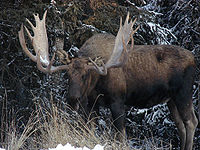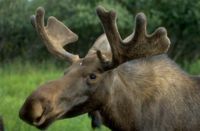Moose
 From Conservapedia
From Conservapedia | Moose | |
|---|---|

| |
| Scientific classification | |
| Kingdom Information | |
| Domain | Eukaryota |
| Kingdom | Animalia |
| Subkingdom | Bilateria |
| Branch | Deuterostomia |
| Phylum Information | |
| Phylum | Chordata |
| Sub-phylum | Vertebrata |
| Infraphylum | Gnathostomata |
| Class Information | |
| Class | Mammalia |
| Sub-class | Theriiformes |
| Infra-class | Holotheria |
| Order Information | |
| Superorder | Preptotheria |
| Order | Artiodactyla |
| Sub-order | Ruminantia |
| Family Information | |
| Superfamily | Cervoidea |
| Family | Cervidae |
| Sub-family | Odocoileinae |
| Tribe Information | |
| Tribe | Alceini |
| Genus Information | |
| Genus | Alces |
| Species Information | |
| Species | A. alces |
| Subspecies | A. A. alces A. a. americanus A. a. andersoni A. a. cameloides † A. a. caucasicus A. a. gigas A. a. shirasi |
| Population statistics | |
The moose (Alces alces) is the world's largest deer. Moose are generally associated with northern forests in North America, Europe, and Asia. In Europe they are called elk. The name moose comes from the Proto-Algonquian word mooswa, meaning "the animal that strips bark off of trees."
Contents
- 1 Description
- 1.1 Subspecies
- 2 Habitat and diet
- 2.1 Natural predators
- 3 Reproduction
- 4 Relation with man
- 5 Moose in history
- 6 Moose in popular culture
- 7 See also
- 8 References
Description[edit]
Moose are long-legged and heavily bodied with a drooping nose, a dewlap of loose flesh (called a 'bell') under their chin, and a tiny tail. Their color ranges from golden brown to almost black, depending upon the season and the age of the animal. Males in prime condition weigh from 1,200 to 1,600 pounds, with the Alaskan subspecies (A. A. gigas) the largest. Adult females weigh 800 to 1,300 pounds. Only the males moose have antlers, producing trophy-size antlers when they are 6 or 7 years old, but the largest antlers are grown at approximately 10 to 12 years of age. In the wild, moose rarely live more than 16 years.[1]
Moose are color-blind, although they see well in low light. Because of their eye position, they have a large blind spot directly in front of them and have to roll their eyes forward to see things there. However, they can move both their eyes and ears independently of each other. They compensate for their poor eyesight by having excellent senses of hearing and smell.
Subspecies[edit]
- A. A. alces; Northern Europe, and known as the Eurasian elk.
- A. a. americanus; found in northeastern North America.
- A. a. andersoni, central North America, as far south as North Dakota, Minnesota, Wisconsin, and northern Michigan, and north to Nunavut, Northwest Territory, and the Yukon.
- A. a. cameloides, far east Siberia, Mongolia, northern China.
- A. a. caucasicus; formerly of the Caucausus area of Europe and Asia, now extinct.
- A. a. gigas; Alaska and the Yukon of Canada, largest subspecies.
- A. a. shirasi, Montana, Idaho, Colorado, Wyoming, Utah, Oregon, and Washington.
Habitat and diet[edit]
They are most abundant in recently burned areas that contain willow and birch shrubs, on timberline plateaus, and along major rivers, striping leaves and twigs off hardwood trees for food - moose eat 40-50 lbs of vegetation in a day. In winter they feed on balsam fir, but the nutritional value of this is too low to sustain them permanently. They also eat grass and lichen and other plants from the forest floor. They are ruminants that chew the cud like cows, and have a similar four-chambered stomach. Moose are good swimmers and can browse underwater on pondweed, underwater plants and water lilies; they also submerge themselves to gain relief from biting insects. Moose are most active at dawn and dusk, and most likely to be seen near roads between mid-May and July, where they lick salt left on the roads from winter.[2]
Natural predators[edit]
The natural predators of moose are wolves, black and brown bears and wolverines. Black bears take moose calves in May and June. Brown bears kill calves and adults the entire time the bears are out of their winter dens and not hibernating, with wolves killing moose throughout the year.
Reproduction[edit]

Moose breed in the fall with the peak of the rutting activities coming in late September and early October. During mating season, males splash their bells with urine-soaked mud to attract females.[3] Adult males joust during the rut by bringing their antlers together and pushing. Serious battles are rare. Bulls may receive a few punctures or other damage and occasionally die from their wounds. The winner usually mates with all the females. By late October, once the adult males have exhausted their summer accumulation of fat and their desire for female company, they begin feeding. Antlers are shed as early as November, but mostly in December and January.
Newborn calves weigh 28 to 35 pounds and within two months grow to over 400 pounds. Calves is generally reddish brown fading to a lighter rust color within a few weeks.
Relation with man[edit]
Native Americans ate moose meat for protein. The meat was dried and used as jerky as well as eaten fresh. No part of the animal went to waste – tribal peoples also tanned the hides and turned them into clothing and shoes, using strips of rawhide to make laces and straps. They carved antlers and used them as tools and for artwork and to function as buttons. The hair was used for decoration, and to make fishing flies.
With the decline of the natural predators of moose, tree regeneration declines as moose populations increase. States with large moose populations therefore hold annual lotteries for a limited number of hunting licenses. Moose are hunted in Alaska, most famously by Sarah Palin.
Although never domesticated, tame moose have served as work animals, as can be seen in these historical photographs:
- Moose hauling wood (Quebec, c.1930) [1]
- Moose pulling a wagon (Alberta, 1898) [2]
- Moose pulling a wagon (Skaguay, Alaska, date unknown) [3]
Moose in history[edit]
According to the Life of Venerable Macarius of Unzha, in 1439 the Miracle of the Moose saved the saint and his companions from starvation. While traveling, they ran out of food. They captured a trapped moose, but because it was a fast time Venerable Macarius made them cut its right ear off and release it instead of eating it, and told them the animal would come again at the Feast of St Peter and St Paul in three days’ time. When the day arrived, the moose duly returned in response to Macarius’ prayers, and surrendered itself for slaughter.[4]
The astronomer Tycho Brahe had a pet moose. The moose appears in a correspondence between Brahe and Lantgrave Wilhelm of Kassel in Germany, in which they discuss moose and reindeer. Brahe described how his tame moose had climbed the stairs of the castle of Landskrona, where he had taken it in order to entertain the lord of the castle. However, sadly, the moose then drank such huge quantities of beer that it fell down the stairs, broke a leg, and died.[5]
The United States Progressive Party of 1912 was nicknamed the ‘Bull Moose party’. It was formed by Theodore Roosevelt when he lost the Republican nomination to Howard Taft during the 1912 presidential election campaign. Roosevelt, a hearty outdoors type, retorted to reporters who suggested he was not fit for the office that he was "fit as a bull moose". Ironically for such a masculine-sounding party, it had more women in leadership positions than any previous party and strongly advocated women’s rights. This led both the Republican and Democrat candidates to do the same. The Vermont Progressive Party still uses a moose as their logo.
Moose in popular culture[edit]
The moose is the official animal of Canada, Sweden, Norway and the State of Maine. It is also the mascot of the Seattle Mariners baseball team, Monchegorsk in Lapland and the City of Dryden in Ontario.[6] Toronto displayed and then auctioned over 500 moose statues in 2000, to attract tourists and generate funds for the Canadian Olympics.
Moose have been portrayed in films on occasion, with the opening sequence to the television series Northern Exposure being the most familiar to today's audiences.[7] In the early 1960s the moose familiar to most Americans was Bullwinkle, star of Jay Ward's animated Rocky and Bullwinkle Show.[8][9] The 2003 Disney film Brother Bear has two moose brothers named Rutt and Tuke as comic relief major characters; both are respectively voiced by Rick Moranis and Dave Thomas, modeled off of the Canadian comic duo Bob and Doug McKenzie (also played by Rick Moranis and Dave Thomas).
Moose don’t usually thrive in captivity, but in South Portland, Maine, is the world's largest (and perhaps only) life-sized chocolate moose. He's called Lenny, is 8 feet tall and 9 feet long, and is made of 1,700 lbs of milk chocolate.[10]
The Loyal Order of Moose was founded in 1888 as a means of social networking, but now carries out community service projects. It chose moose as its emblem because moose are large powerful animals that are not predators. It has 1.6 million members internationally and several thousand lodges in the US, Canada, the UK and Bermuda. Its headquarters are in Mooseheart, Illinois, which has a house for the orphans of members, and they have a home called Moosehaven in Florida, for aged Moose. In the first half of the 20th century, it provided social security benefits for its largely working-class membership at a time when the government provided no safety net to the wives or children of men who either died or became disabled.
There are also Elk Lodges, which were founded earlier – The Benevolent and Protective Order of Elks was founded in New York City in 1868, and was originally a society of actors and writers.
See also[edit]
- Deer, Elk
- Hunting with:
- Firearms: Handgun, Shotgun and Rifle
- Archery: Crossbow, Compound bow
- Fishing
References[edit]
- ↑ http://www.smouse.force9.co.uk/facts2.htm
- ↑ http://portlandme.about.com/library/howto/htmoose.htm
- ↑ http://portlandme.about.com/cs/moose/a/MooseMating.htm
- ↑ https://en.wikipedia.org/wiki/Miracle_of_the_Moose
- ↑ http://www.nada.kth.se/~fred/tycho/nose.html
- ↑ http://www.cityofdryden.on.ca/max.shtml
- ↑ https://www.youtube.com/watch?v=2E5Kzw7RMuU
- ↑ https://www.youtube.com/watch?v=65t-OzhlmvE
- ↑ http://bullwinkle.toonzone.net/
- ↑ http://www.lenlibby.com/lenny.htm
Categories: [Animals] [Deer] [Hunting] [American Redoubt] [Idaho] [Montana] [Alaska] [Canada] [Kosher Animals]
↧ Download as ZWI file | Last modified: 02/18/2023 17:39:15 | 38 views
☰ Source: https://www.conservapedia.com/Moose | License: CC BY-SA 3.0
 ZWI signed:
ZWI signed: KSF
KSF